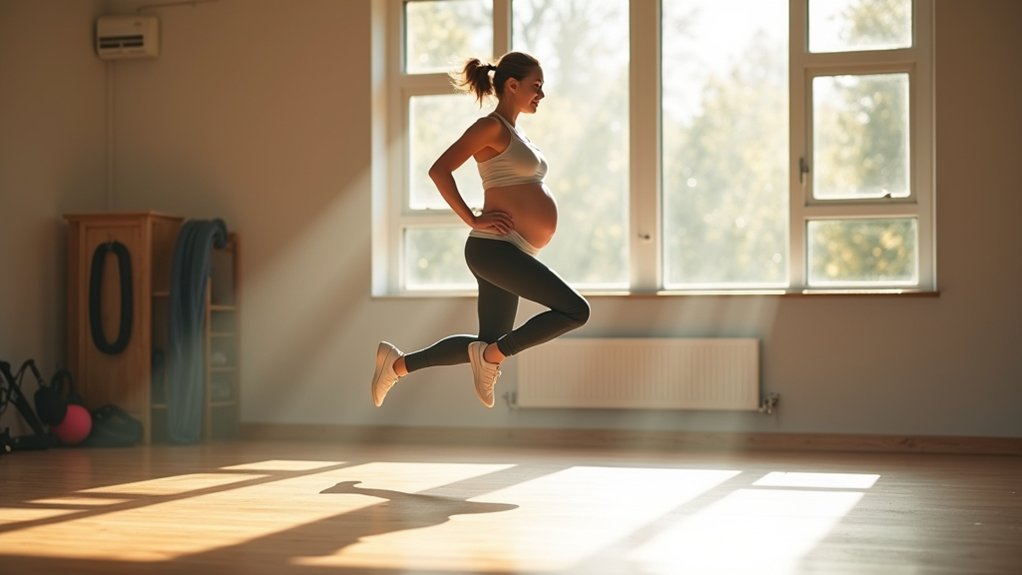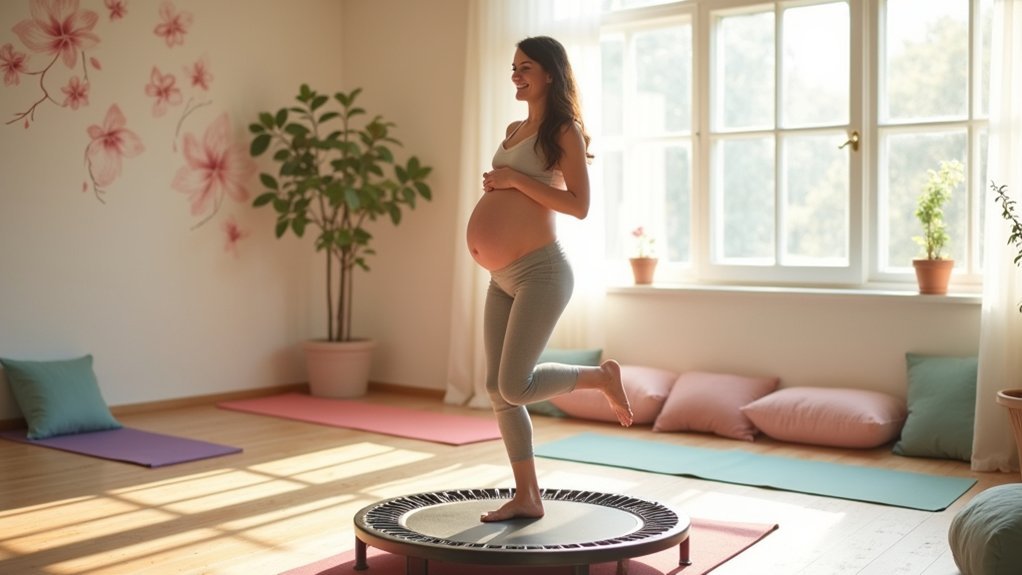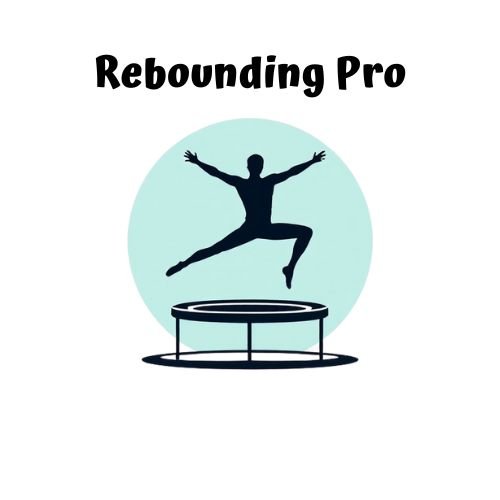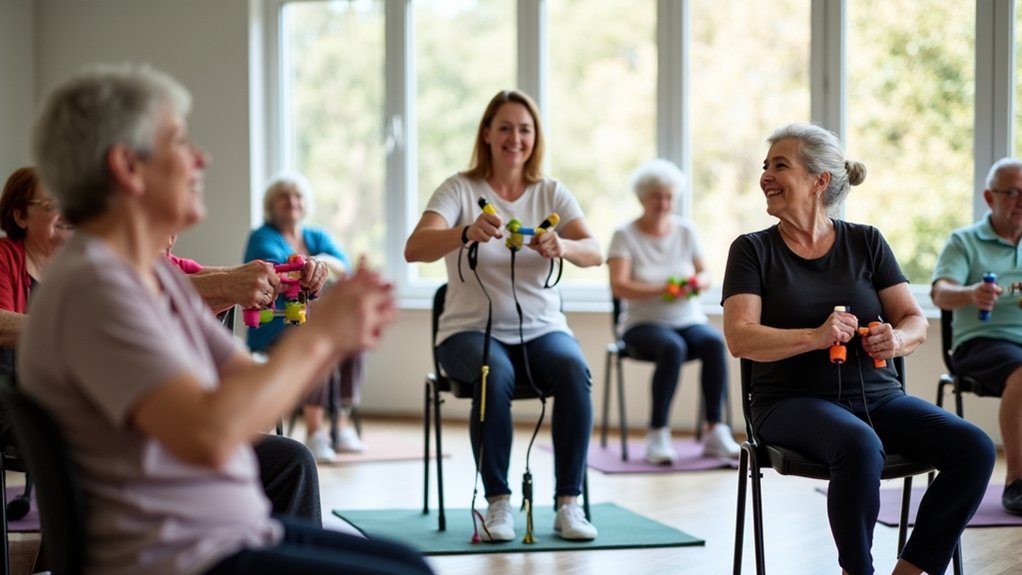Mini-trampoline workouts during pregnancy can be joint-friendly when modified correctly. The trampoline surface absorbs up to 87% of impact forces, protecting your knees and ankles while improving circulation. Keep bounces low (1-2 inches), engage your pelvic floor, and always use a handlebar for stability. Start with 10-15 minute sessions and adapt exercises for each trimester. Always get your healthcare provider’s approval before starting this beneficial low-impact exercise routine.
Why Rebounding Can Be Adapted for Pregnancy

While many high-impact exercises become challenging during pregnancy, rebounding offers a surprisingly suitable alternative for expectant mothers. The trampoline surface absorbs up to 87% of impact force, dramatically reducing stress on your changing joints while still delivering cardiovascular benefits. However, pregnant women should prioritize low-impact exercises to prevent potential pelvic floor injury risks.
You’ll appreciate how rebounding improves your spatial awareness and coordination—crucial as your center of gravity shifts throughout pregnancy. The activity’s intensity can be easily adjusted by controlling bounce height, adapting to your changing needs as you progress through trimesters.
With proper form and core engagement, you’ll experience less downward pressure on your pelvic floor compared to running.
Bounce safely, protect your pelvic floor—rebounding creates less downward pressure than traditional running when done correctly.
The improved circulation from regular rebounding may even help manage pregnancy complications like gestational diabetes and hypertension risks.
Joint-Protective Modifications for Pregnancy Rebounding
As your pregnancy progresses, protecting your joints becomes increasingly important during rebounding exercises. Maintain a neutral pelvic alignment by stacking your ribs over your pelvis and engaging your deep core muscles before bouncing. This prevents harmful anterior pelvic tilt that strains your SI joints.
Modify your rebounds by reducing jump height and slightly bending your knees to absorb impact. “Zip up” your pelvic floor during active bouncing phases, coordinating with exhalation, but avoid constant tension. Always prioritize safety by consulting healthcare providers before beginning any rebounding routine during pregnancy.
Choose a rebounder with adequate mat tension for shock absorption and never place it on hard surfaces like concrete. Wear supportive footwear if barefoot jumping feels unstable.
Consider alternating bouncing with marching steps and limit sessions to 10-15 minutes to prevent form breakdown from fatigue.
The Science Behind Low-Impact Jumping During Pregnancy

The scientific evidence supporting low-impact jumping during pregnancy offers reassurance for expectant mothers seeking safe exercise options. When performed correctly, low-impact jumping stimulates endorphin release, improving your mood and stress management capabilities during this transformative time.
Research shows that exercise—including modified rebounding—is associated with impressive benefits: higher rates of vaginal delivery, reduced gestational diabetes risk, and improved pelvic floor muscle tone. Studies demonstrate that pregnant women maintain lower core temperatures during exercise compared to non-pregnant women, reducing concerns about maternal hyperthermia. The American College of Obstetrics and Gynecology supports regular physical activity throughout pregnancy.
While your body undergoes significant cardiovascular and hormonal changes, low-impact exercise helps maintain muscle tone and joint stability.
With an injury rate of only 4.1 per 1,000 exercise hours, the benefits typically outweigh risks when you avoid overheating and monitor fetal health regularly.
Essential Equipment for Safe Pregnancy Rebounding
Selecting proper equipment forms the foundation of your prenatal rebounding routine. Choose a mini trampoline with a handlebar for stability and bungee cord suspension to minimize joint impact.
Make certain your rebounder has a non-slip mat surface and exceeds your weight by at least 50 pounds to accommodate pregnancy changes.
For footwear, opt for Bounti Soles/Socks or low-profile shoes (under 1″ thick) with moisture-wicking properties rather than going barefoot.
Look for CE/TÜV certification and spring-free designs to eliminate pinch hazards.
Maintain your equipment with alcohol-free cleaners and weekly tension checks.
When shifting postpartum, seek rebounders with pelvic floor-friendly bounce angles (less than 50°) and compatibility with birth balls for cross-training during recovery.
For maximum safety and durability, consider the Bungee Studio Deluxe Rebounder with its 160kgs weight capacity to provide ample support throughout your pregnancy journey.
Five Gentle Rebounding Exercises for Each Trimester

As your body changes throughout pregnancy, you’ll need specific rebounding exercises that adapt to each trimester.
During your first trimester, start with gentle bounces that gradually increase in intensity as your comfort allows, always monitoring how your body responds. It’s important to consult your doctor before starting any physical activity during pregnancy to ensure it’s safe for your specific situation.
These trimester-specific routines can be modified week by week to accommodate your changing center of gravity and growing baby.
First Trimester Bounces
During your first trimester, gentle rebounding exercises can maintain fitness while protecting your changing body and developing baby.
Try these five safe options:
Start with two-legged low bounces (just 1-2 inches high) on a mini-trampoline to stimulate lymphatic flow without jarring your pelvis.
On a stability ball, practice seated pelvic tilts to strengthen your lower back and promote ideal fetal positioning.
Incorporate gentle bouncing on your birthing ball to improve core engagement while doing Kegel exercises simultaneously.
For cardio benefits, try 30-second intervals of arm-swing rebounds, alternating with marching in place.
Finally, seated figure-eights on your ball maintain joint mobility through controlled movement. These movements are similar to the hip circles demonstrated in Lindsey Baumgren’s pregnancy ball warm-up routine.
Always wear cushioned shoes, stay hydrated, and stop immediately if you experience dizziness or discomfort.
Keep sessions under 10 minutes initially.
Modifications By Week
Your changing body requires specific adaptations to rebounding exercises as your pregnancy progresses week by week. During weeks 1-12, focus on gentle rebound walking and modified bounces that maintain cardiovascular health without jarring movements. Always remember to limit max efforts with rebounding exercises as you progress through pregnancy, just as you would with other forms of exercise.
| Weeks | First Trimester | Second Trimester | Third Trimester |
|---|---|---|---|
| Technique | Rebound walking | Knee repeaters | Seated leg raises |
| Intensity | Moderate | Low-moderate | Low |
| Duration | 20-30 min | 15-20 min | 10-15 min |
| Surface | Firm rebounder | Rebounder with stability bar | Chair exercises |
As you enter weeks 13-26, shift to knee repeaters and wall push-ups that strengthen without strain. By weeks 27-40, prioritize seated exercises like pelvic tilts and gentle leg raises that maintain muscle tone while protecting your joints and growing baby.
Progressive Intensity Protocols
Effective rebounding during pregnancy requires a carefully calibrated approach that evolves with each trimester.
In your first trimester, focus on foundation exercises like static stance holds, seated pelvic tilts, and gentle breathing drills with minimal knee lifts.
Your second trimester allows for movement integration through lateral weight transfers, march-in-place exercises, and light seated dumbbell work. Keep your feet in constant contact with the rebounder.
Third trimester exercises prioritize stability with hands-assisted bouncing, wall-supported partial squats, and seated figure-8 hip circles to maintain mobility. Always use a rebounder with a safety handlebar to prevent potential balance issues that commonly occur during pregnancy.
Throughout all trimesters, gradually increase from 10-15 minute sessions to 20-25 minutes, maintaining a 1:3 work-rest ratio.
Start with bodyweight-only exercises, adding 1-3lb weights only in your second trimester if comfortable.
Monitoring Your Body’s Response to Mini-Trampoline Workouts
During mini-trampoline workouts, you’ll need to monitor your heart rate for warning signs like dizziness or excessive fatigue, which signal it’s time to slow down or stop.
Choose breathable clothing that accommodates your growing belly, allowing you to maintain comfortable breathing patterns throughout your exercise session.
After jumping, take time for proper recovery by stretching gently, rehydrating, and noting how your body feels so you can adjust future workouts accordingly. Always consult your healthcare provider before beginning any trampoline exercise routine during pregnancy.
Heart Rate Warning Signs
While enjoying the low-impact benefits of mini-trampoline workouts during pregnancy, monitoring your heart rate becomes essential for both maternal and fetal safety. Your resting heart rate will naturally increase by 10-20 BPM during pregnancy, but watching for warning signs helps prevent overexertion. Regular monitoring can prevent unnecessary interventions and provide reassurance if normal.
- Sustained Elevation – If your heart rate exceeds 85% of your maximum (220 minus your age) during rebounding, or doesn’t return to near-normal within 5 minutes post-exercise, take a longer rest.
- Irregular Rhythms – Stop immediately if you experience skipped beats or palpitations.
- Talk Test Failure – If you can’t speak in full sentences during your workout, you’re working too hard.
- Post-Exercise Symptoms – Dizziness, lightheadedness, or heart rate above 100 BPM thirty minutes after exercising indicates overtraining.
Breathability During Exercise
Beyond tracking your heart rate, proper breathing during mini-trampoline workouts becomes a key indicator of your body’s exercise tolerance during pregnancy.
Maintain a “conversational pace” throughout your routine—if you can’t speak comfortably, you’re likely overexerting yourself.
Sync your nasal breathing rhythm with your bouncing tempo and exhale during upward movements to prevent breath-holding that increases abdominal pressure.
Keep your torso upright to give your diaphragm full expansion room.
Limit sessions to 15-20 minutes to prevent overheating, and hydrate every 5-7 minutes.
For maximum comfort, try micro-bouncing (under 3 inches), lateral weight shifts, or handrail-assisted movements. Always listen to your body and stop immediately if you experience discomfort or unusual symptoms.
As your pregnancy progresses, reduce bounce height and duration while focusing on diaphragmatic breathing during warm-ups to enhance oxygen efficiency.
Post-Jump Recovery Needs
Recognizing your body’s signals after mini-trampoline sessions becomes essential for pregnancy safety and long-term wellness.
Listen to what your body is telling you—discomfort means stop immediately and reassess your activity level.
After your bounce session:
- Check for unusual sensations – Any pain, dizziness, or excessive fatigue requires immediate rest and possibly healthcare consultation.
- Stay hydrated – Drink plenty of water to support your increased blood volume and energy recovery.
- Incorporate pelvic floor exercises – These gentle movements support your changing body and promote post-workout recovery.
- Allow adequate rest time – Your pregnant body needs more recovery between workouts than pre-pregnancy.
Remember that adapting your recovery routine as your pregnancy progresses isn’t just beneficial—it’s necessary for protecting both you and your baby.
During recovery, avoid activities that place strain on your loosened tissues, as pregnancy hormones cause significant loosening of tissues throughout your pelvic region.
Combining Rebounding With Pelvic Floor Strengthening
Rebounding offers a unique opportunity to enhance pelvic floor strength when combined with intentional muscle engagement techniques. For best results, perform Kegel contractions during gentle bounces, activating all three layers of your pelvic floor muscles simultaneously.
Maintain proper posture with a neutral spine and engaged transverse abdominals while on the rebounder. This reinforces the core-pelvic connection that supports your growing belly. Remember to avoid excessive zipping during longer rebounding sessions as this can potentially lead to muscle tension and dysfunction.
Start with 10-minute sessions of controlled, low-amplitude movements, gradually increasing duration as your strength improves. The rebounder’s unstable surface naturally activates your core and pelvic floor muscles, creating isometric contractions that build endurance.
For safety, always use a handlebar for balance and immediately stop if you experience pain in your pubic area or lower back.
When to Pause Your Rebounding Routine During Pregnancy
Although rebounding offers many benefits during pregnancy, there are specific situations when you should temporarily pause your routine for safety.
Always prioritize your wellbeing and your baby’s health by recognizing when to take a break.
- Discomfort or pain – Stop immediately if you experience any abdominal pain, dizziness, shortness of breath, or unusual discomfort during your session.
- Bleeding or spotting – Cease activity and contact your healthcare provider if you notice any vaginal bleeding.
- After the 28th week – Consider switching to gentler exercises in the third trimester as your center of gravity shifts considerably.
- Medical complications – Pause rebounding if you develop pregnancy-related conditions like preeclampsia, gestational diabetes, or placenta previa.
Remember to obtain clearance from your doctor before resuming your routine. Current guidelines recommend avoiding positions that place your buttocks higher than chest after the first trimester as this can impact blood flow and fetal development.
Frequently Asked Questions
Can Rebounding Jumpstart Labor in Late Pregnancy?
Rebounding might help start labor through stimulating cervical ripening and encouraging fetal descent, but there’s limited direct evidence. You’ll likely see better results combining it with other biomechanical movements like walking and hip rotations.
How Does Rebounding Affect Morning Sickness in the First Trimester?
Rebounding’s effect on morning sickness varies individually. You might find it eases symptoms through improved circulation and reduced stress, but it could worsen nausea if you’re sensitive to motion. Always consult your healthcare provider first.
Are There Specific Shoes Recommended for Pregnancy Rebounding?
You’ll want supportive sneakers with wide toe boxes, arch support, and cushioned midsoles for rebounding during pregnancy. Look for adjustable fits like Brooks Adrenaline GTS 23 or Hoka Cliftons to accommodate swelling feet.
Can Rebounding Help Reduce Pregnancy-Related Varicose Veins?
Yes, rebounding can help reduce pregnancy-related varicose veins by improving circulation and enhancing venous return. You’ll benefit from the gentle bouncing that stimulates blood flow while minimizing pressure on your already strained veins.
Is Rebounding Safer Than Swimming for Women With Placenta Previa?
No, rebounding isn’t safer than swimming if you have placenta previa. Swimming’s buoyancy reduces placental stress, while rebounding’s downward forces increase bleeding risks. You’ll want to choose swimming and avoid high-impact activities entirely.
In Summary
You’ve now got the tools to make rebounding a safe part of your pregnancy fitness routine. Remember to adapt exercises to your changing body, invest in quality equipment, and always listen to your body’s signals. By combining low-impact jumps with proper technique, you’ll protect your joints while maintaining strength throughout your pregnancy. Don’t hesitate to consult your healthcare provider with any concerns along the way.




Leave a Reply